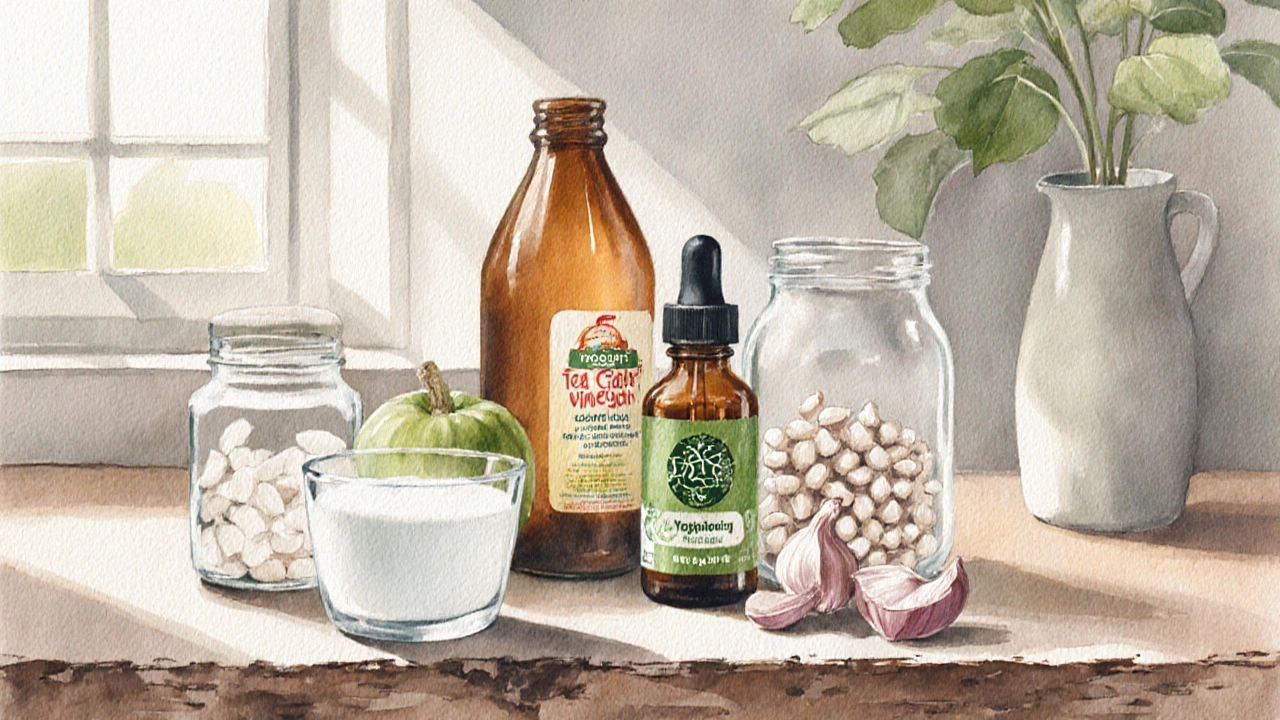BV Treatment Decision Tool
Personalize Your BV Treatment Options
Answer a few questions about your situation to get evidence-based recommendations
Evidence-Based Recommendations
Remedy Comparison
Safety Considerations
When you’re dealing with an uncomfortable discharge, a fishy odor, or itching, the first thought isn’t usually “home remedy.” Yet many women wonder if bacterial vaginosis natural remedies can actually clear the infection without a prescription. Below we break down what BV is, which natural options are circulating online, how solid the science really is, and what you should do before you DIY.
What Exactly Is Bacterial Vaginosis?
Bacterial Vaginosis is a vaginal condition caused by an imbalance in the normal microbiome, where harmful anaerobic bacteria overgrow and reduce protective lactobacilli. It’s the most common vaginal complaint in reproductive‑age women, affecting roughly 1 in 3 at some point.
The key signs include thin grayish discharge, a noticeable fish‑like smell, and mild irritation. Diagnosis usually relies on a pelvic exam, a "wet mount" microscopy, or the Amsel criteria (discharge, pH >4.5, clue cells, and odor after whiff test).
Because BV isn’t a sexually transmitted infection, it can recur even after successful treatment. The gold‑standard therapy is a short course of antibiotics-typically metronidazole or clindamycin-but many seek alternatives to avoid side‑effects, resistance, or the desire for a more natural approach.
Why Natural Remedies Get So Much Buzz
Online forums, wellness blogs, and even some clinicians tout options ranging from yogurt to essential oils. The appeal is simple: low cost, easy access, and the feeling of “taking care of yourself.” But not every trendy tip holds up under scrutiny.
Below are the most talked‑about candidates, grouped by how they’re supposed to work.
- Probiotic yogurt (or oral probiotic capsules) - aims to restore Lactobacillus species that keep pH low.
- Tea tree oil - a potent antiseptic believed to kill anaerobes.
- Apple cider vinegar (diluted) - thought to acidify the vagina.
- Boric acid suppositories - used for recurrent infections, supposedly restoring pH and reducing pathogens.
- Garlic, hydrogen peroxide rinses, and coconut oil - less studied but often mentioned.
How Well Do These Remedies Actually Work?
We’ll look at the scientific backing, typical success rates, and safety considerations. The evidence comes from a mix of small clinical trials, laboratory studies, and real‑world observations up to 2024.
| Remedy | Evidence Level | Typical Cure Rate | Side‑effects / Risks | Cost (US$) |
|---|---|---|---|---|
| Metronidazole (prescribed) | High (RCTs & meta‑analysis) | 80‑90% | Nausea, metallic taste, rare allergic reaction | 10‑20 |
| Probiotic yogurt / oral capsules | Moderate (few RCTs, mixed results) | 30‑45% | Generally safe; rare GI upset | 5‑15 per month |
| Tea tree oil (topical) | Low (in‑vitro, small pilot) | ~20% (subjective relief) | Skin irritation, allergic dermatitis | 8‑12 |
| Apple cider vinegar (diluted rinse) | Low (case series) | ~15‑25% | Burning, pH disruption if over‑diluted | 2‑5 |
| Boric acid suppositories | Moderate (controlled trials for recurrent BV) | 55‑70% sustained remission | Vaginal irritation, toxicity if ingested | 10‑20 for a 30‑day pack |
Key takeaways:
- Prescription antibiotics remain the most reliable first‑line cure.
- Probiotics can help maintain remission, especially after antibiotics, but they rarely clear an active infection on their own.
- Tea tree oil and apple cider vinegar lack robust human data; they may provide temporary symptom relief but risk irritation.
- Boric acid shows promise for stubborn, recurrent cases, yet it must be used correctly and is not recommended during pregnancy.

How to Use Probiotics Safely
If you decide to try a probiotic route, follow these evidence‑backed steps:
- Choose a product containing Lactobacillus rhamnosus or Lactobacillus reuteri, strains that have demonstrated vaginal colonisation.
- Take the recommended dose (usually 1‑2billion CFU) once daily for at least 30days.
- Combine with a low‑sugar, high‑protein diet; excess sugar can feed harmful bacteria.
- Consider adding a daily serving of plain, unsweetened yogurt (with live cultures) as a dietary booster.
Stop the probiotic if you notice increased itching, burning, or a new discharge-those could signal an adverse reaction.
Tea Tree Oil and Apple Cider Vinegar: DIY Caution
Both are acidic or oily substances that can disturb the delicate vaginal pH (normally 3.8‑4.5). If you still want to experiment:
- For tea tree oil, dilute 1drop in 1teaspoon of carrier oil (like coconut oil) and apply only to the outer labia. Never insert it.
- For apple cider vinegar, mix 1part vinegar with 4parts warm water, use a clean squeeze bottle, and rinse the external area for no longer than 5minutes. Avoid internal use.
Never use these treatments more than twice a week; excessive use can raise the pH and actually worsen BV.
Boric Acid: When It Might Be Worth a Shot
Boric acid comes as 600mg capsules designed for vaginal insertion. Research in 2022‑2023 showed that a 14‑day course reduced recurrence by about 60% compared to placebo.
Use only if:
- You’ve completed an antibiotic course and symptoms return within a month.
- You’re not pregnant or breastfeeding (safety not established).
- You follow the manufacturer’s instructions: insert one capsule nightly at bedtime for 14days, then let the vagina rest for a week before a second cycle if needed.
Watch for signs of irritation or a burning sensation-stop immediately and consult a clinician.

When to Call a Healthcare Provider
Even the best natural plan can’t replace professional care in certain situations. Seek medical attention if you experience any of the following:
- Severe pelvic pain or fever (possible pelvic inflammatory disease).
- Symptoms persist beyond 7days despite treatment.
- Pregnancy or plans to become pregnant (BV can affect pregnancy outcomes).
- Repeated episodes (more than three in a year) - you may need a tailored antibiotic regimen.
Early treatment reduces the risk of complications like preterm birth, infertility, or spreading infection to a partner.
Quick Checklist: Natural BV Management
- Confirm diagnosis with a healthcare professional.
- Start with a prescribed antibiotic if symptoms are acute.
- After antibiotics, add a probiotic containing Lactobacillus rhamnosus or Lactobacillus reuteri for 30days.
- Consider boric acid suppositories for recurrent cases, following safety guidelines.
- Avoid over‑use of tea tree oil or apple cider vinegar; limit to twice weekly and watch for irritation.
- Maintain good hygiene: cotton underwear, avoid scented douches, and keep the vaginal area dry.
Frequently Asked Questions
Can probiotics cure bacterial vaginosis on their own?
Probiotics alone rarely eradicate an active BV infection. The strongest data show they help maintain remission after antibiotics, especially strains like Lactobacillus rhamnosus and Lactobacillus reuteri. If you have symptoms, start with a prescription and add probiotics afterward.
Is apple cider vinegar safe to use inside the vagina?
Only a very diluted rinse (1:4 vinegar to water) applied to the external area is considered low‑risk. Direct insertion can damage the natural pH and cause burning. Most clinicians do not recommend internal use.
How long does it take for boric acid to work?
A typical regimen is 14 nightly inserts. Many women notice a reduction in discharge and odor within 5‑7days, but full remission often requires the full course. A second cycle may be needed for stubborn cases.
Can BV be prevented after treatment?
Prevention focuses on maintaining a healthy vaginal microbiome: avoid douching, wear breathable cotton underwear, limit sugary foods, and consider daily probiotics. Some clinicians also suggest a short post‑antibiotic probiotic course to keep lactobacilli dominant.
Should I use a natural remedy if I’m pregnant?
Pregnancy changes vaginal chemistry, and untreated BV can raise the risk of preterm birth. Stick to doctor‑prescribed antibiotics; most natural options (especially boric acid) lack safety data for pregnancy.


Author
Mike Clayton
As a pharmaceutical expert, I am passionate about researching and developing new medications to improve people's lives. With my extensive knowledge in the field, I enjoy writing articles and sharing insights on various diseases and their treatments. My goal is to educate the public on the importance of understanding the medications they take and how they can contribute to their overall well-being. I am constantly striving to stay up-to-date with the latest advancements in pharmaceuticals and share that knowledge with others. Through my writing, I hope to bridge the gap between science and the general public, making complex topics more accessible and easy to understand.